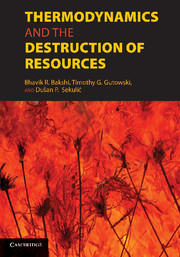Book contents
- Frontmatter
- Contents
- Contributor List
- Foreword by Herman E. Daly
- Foreword by Jan Szargut
- Preface
- Introduction
- PART I FOUNDATIONS
- PART II PRODUCTS AND PROCESSES
- PART III LIFE-CYCLE ASSESSMENTS AND METRICS
- PART IV ECONOMIC SYSTEMS, SOCIAL SYSTEMS, INDUSTRIAL SYSTEMS, AND ECOSYSTEMS
- Appendix: Standard Chemical Exergy
- Index
- References
Introduction
Published online by Cambridge University Press: 01 June 2011
- Frontmatter
- Contents
- Contributor List
- Foreword by Herman E. Daly
- Foreword by Jan Szargut
- Preface
- Introduction
- PART I FOUNDATIONS
- PART II PRODUCTS AND PROCESSES
- PART III LIFE-CYCLE ASSESSMENTS AND METRICS
- PART IV ECONOMIC SYSTEMS, SOCIAL SYSTEMS, INDUSTRIAL SYSTEMS, AND ECOSYSTEMS
- Appendix: Standard Chemical Exergy
- Index
- References
Summary
Resources and Sustainability
This book is about the application of thermodynamic thinking to those new areas of study that are concerned with the human use of resources and the development of a sustainable society. Exactly what a sustainable society is, is a highly debated topic, somewhat subject to personal value preferences. However, what is not sustainable is easier to identify. For example, in Jared Diamond's popular book, Collapse [1], he identified a variety of ancient and modern societies that failed. No one would dispute this claim. Although the reasons for these failures were complex, an important and common contributing factor was an inability to manage Earth's resources and thereby meet the needs of the society. For example, the inhabitants of Easter Island apparently became consumed with building giant stone statues (called moai), which required large timbers for their construction and for their transport from the quarry to the installation site. Apparently this building process, along with the destruction of the seeds wrought by the Polynesian rats, led to the destruction of most, if not all, of their trees. One result from this was a loss of the primary building material for their canoes. Because most fish were some distance from the shore, a lack of building materials for canoes meant fewer fish to eat and the inability to move to other islands. This desperate situation ultimately resulted in the islanders resorting to cannibalism.
- Type
- Chapter
- Information
- Thermodynamics and the Destruction of Resources , pp. 1 - 12Publisher: Cambridge University PressPrint publication year: 2011



